Menus
- Sexy sixty
- Discovery
- In the saddle
- In the city
- Motorway and expressways
- Departmental
- Cycle part
- Braking
- Comfort / Duo
- Conclusion
- Colors
- Indian Scout and Scout Sixty Differences
Sexy sixty
For his big comeback Indian combines his legendary Scout, in a less powerful, less worked and less expensive version. Closer to the aesthetics of the 1920 model, the Scout Sixty seeks the authenticity of a bobber with character.
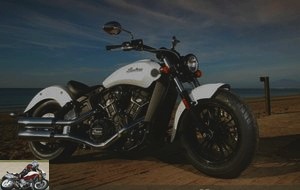
Indian, motorcycle legend since 1901, is reborn 110 years after its creation with its takeover by the American group Polaris. In the meantime, the company had first stopped production in 1953 then experienced successive revivals and stops between 1998 and 2008. Renowned, the brand is the creator of historic technical innovations, such as the invention in 1903 of the V-twin. (42 °) with four valves per cylinder or the first electric starter. The Minnesota firm enjoys a prominent sporting past, with numerous participations in the Isle of Man TT and the Pikes Peak Race.
One of its most emblematic models was the Indian Scout, presented in October 1919. Powered by a 600cc side-valve V-twin, the machine aroused many biker vocations. Efficient and reliable, a 1926 copy was the base, largely transformed, used by the New Zealander Burt Munro to establish his world speed record. The 295.453 km / h (183.586 mph) achieved in 1967 on Bonneville Salt Flats remain unbeatable in their class (and corrected to 296.259 km / h (184.087 mph) by WADA in 2014).
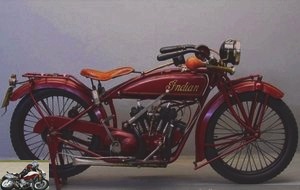
For Indian’s comeback in 2013, the Indian Chieftain and Roadmaster models were the first to be presented, taking up the very classic image of American cruisers. Faced with the European enthusiasm, Indian is developing a market study to produce, in 2014, a much less conventional machine, the Scout. Based on the eponymous model from 1920, it is now an attractive bomber with character with dynamic lines, uniting the original aesthetic codes with a modernity worked in the yardstick of Indian history. In fact, it incorporates the brand’s very first liquid-cooled engine: a 1,133 cm3 (69 in3) V-twin. A real commercial success, with 7,000 units sold, but only 1,800 in the USA, the Scout is undeniably becoming the new Indian icon. For 2016, the Kings Mountain (North Carolina) firm is presenting a less powerful and more affordable version, the Scout Sixty, that we try along 240 km of varied routes.
Discovery
In Anglo-Saxon measure, the displacement of the "small" Scout amounts to 61 cubic inches, hence the name Sixty. Entry level of the Indian myth, the novelty fully renews the style of its predecessor, but wants to be darker, less ostentatious than its elder. And less expensive. But if the cost hunt is effective, it does not come at the expense of quality, real or perceived. Moreover, only a few details make it possible to distinguish it from its eldest, in particular the little chrome present on its board and the Indian signature on the tank, without "Scout". Also, a black tint covers the frame, handlebars, headlight bowl and shock absorber springs. The engine decoration plates are free of chrome and rim profiles and the surfaces of the cylinder heads are no longer polished. In fact, the Sixty thus sticks even more to the style of the original model, especially in Indian Motorcycle Red..

Its volumes cleverly combine modern lines to compose a classic aesthetic ensemble. The basis of its style, a single main curve, running from the column to the rear wheel axle, poses its design, reminiscent of the brand’s original triangle. The simplicity of this overall design is then dressed in multiple details and style elements. The most remarkable is the extension of the tank with the central plates of the frame, supporting the rear suspensions mounted diagonally. The old-fashioned rigid frame effect is excellent.
Straight and simple curves energize the custom. Compact, the front optic with the black conical bowl lowered on the clean front reinforces the line, freeing the 40 mm fork without adjustment. The top of it concentrates and lets appear many sheaths that will be masked with an optional cover. Slender, flattened and ribbed, the traditional 12.5-liter teardrop tank carves its sharp shoulders with flats. As an extension, the single-seater seat is covered with vinyl and not leather, overhanging the boss of the rear wheel arch. The mudguards adopt a sensual aesthetic, discreetly attached to sturdy internal brackets.
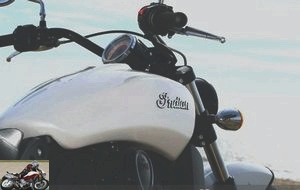
Elegant, the Scout Sixty is also solid, resting on a mixed chassis. Two structures, in cast aluminum linked by steel tubes, integrate the engine block as a semi-supporting element.
The imposing front part forms an interrupted cradle and integrates the steering column higher up. This is linked by two tubular steel sections to the rear frame forming massive and remarkable central plates extending to form the stern. This element refines the machine in its middle and, by itself alone, composes a strong vintage detail. It thus easily supports an optional passenger seat or a luggage rack. Growths support the shock absorbers with adjustable preloading.
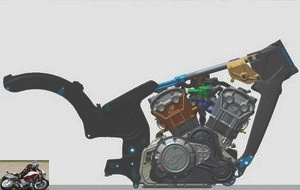
Within this set sits the twin of the Scout Sixty which uses the 60 ° V-Twin injected from its big sister. This imposing engine seems to actually support the machine, its aesthetics also giving it a perceptible power on the outside. Matte, its surfaces boost their molded volumes by the polishing of certain edges and receive two elegant shiny black plates, signed with the logo on the left or the name Indian on the right. Finally, each cylinder head is stamped with the initial while curving of the mark. This modern mechanism is by design…. Helvetique, by Swissauto. If this data may disturb some American bikers, it is also a guarantee of technicality and thus refers to Indian DNA. In addition, the engine is produced in the USA. A notion may be less important in Europe where more performance and character count.
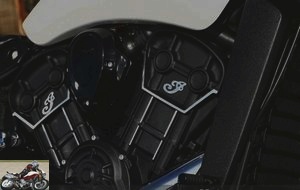
And the twin-cylinder is not lacking, coupled with technology to the latest standards. Double ACT, four valves per cylinder, piston cooling by jets, hydraulic distribution chain tensioners, forged crankshaft, balance shaft and counter-rotating crankshaft (cancels the inertia effect)…. the mechanics are remarkable. And a Ride by Wire type accelerator manages the electronic injection. By reducing the bore by 6 mm, the block is slightly deflated, now with a ratio of its stroke of 93 mm X 73.6 mm. Cubing 999 cm3, it delivers 78 hp and 8.88 da.Nm of torque at 5,600 rpm. It is respectively 20 units less for the first and one for the other, than the Scout. Finally, the gearbox loses a report, its five speeds following better the new pretensions of the engine. But the last one is identical to that of the Scout. Discreet, the collectors spin in two chrome curves towards long straight mufflers, underlining the design of the machine with a sparkling chrome signature.
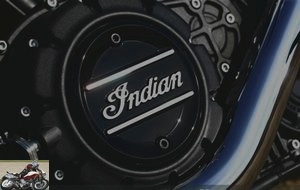
To stop your ride, a two-piston caliper clamps a 298mm track at the front. The opposite retarder, single piston, bites a disc of the same size and the whole is under control of a Bosch ABS. Enough to watch over the rotation of the large 16 "five-spoke rims.
Signed Indian, the gums are of Kenda origin, Taiwanese manufacturer. The steering gear receives a 130/90 tire and the propellant is based on a 150/80, suggesting good agility. And with 256 kg ready to cruiser, the Scout Sixty should show, like its sister, a certain sportiness.
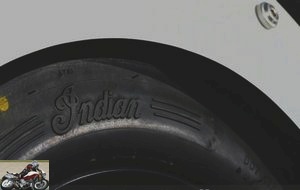
Sporting an excellent finish, the Scout Sixty takes care of the details, with multiple judiciously molded elements, profiled turn signal cabochons mimicking a star and a stylish LED taillight. The tank also has internal welds, taking care of the overall image. We only regret the presence of some sheaths at the level of the handlebars and triple clamps and, by looking carefully, a gear indicator card engaged hardly aesthetic. Finally the commodos could be a little thicker, with a real personality.
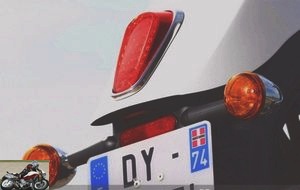
To dress the machine, a complete line of accessories (more than 200 references….) Is available, including many elements to further darken its silhouette (exhausts). The Scout Sixty has been designed for easy customization, allowing you to customize your frame, for example with spoked rims, horn handlebars or performance suspensions. The "1920" leather solo saddle is a particularly attractive "must have".
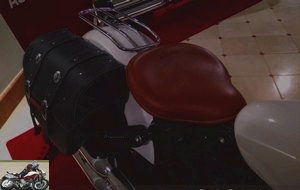
In the saddle
Presented as the lowest in the segment, the saddle rises to 643 mm. Comfortably seated on this stylish solo seat, the Ride "already begins when the legs are stretched slightly to join the footrests attached to the front of the engine. The taller ones will see their knees protrude from the tank, testifying to the low height of the" The arched, wide cow horn hanger naturally accommodates the hands. Its horns plunge towards the structured upper crown and saddles joining together to form a circular ribbed counter block.
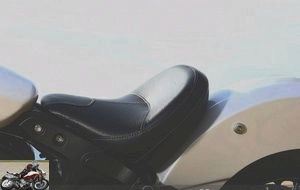
Simple, it has an analog tachometer containing a digital window. The latter displays a gear indicator, the time and, via a trigger on the left stalk, engine speed, oil temperature, odometer and partial. The large levers are not adjustable in spacing, but the hydraulic brake jar is discreet.
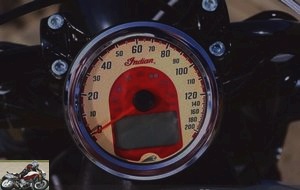
In the city
Attention to the distracted, the switch is fixed on the left side of the engine, between the cylinders. By initializing, the injection gives off a fairly marked roar, quickly interrupted by the hum of the twin cylinder. Really too discreet, the original silencers will be advantageously replaced by adaptable Remus equipping half of our test machines. The sound then conforms to the standards of the genre, crackling at will, giving the Indian back his nasty bobber personality..
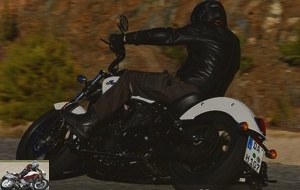
Extremely soft, the controls facilitate handling and ease of use in an urban environment. The same goes for the rather flexible Indian block, with efficient injection and a precise gearbox. Evolving on fourth gear makes the cruiser slowly tremble, without hiccups or jerks from 1500 laps. But when space is available, the scout quickly sets off with a powerful roar, playing mechanics.
With a contained column angle of 29 °, the steering is sufficiently light and the Scout Sixty can easily be taken in traffic. Its large turning radius makes it prefer boulevards, but its lower masses make maneuvering easier. There is also an excellent balance at very low speed. Finally, the teardrop mirrors perfectly inform the pilot, without vibrating.
If it is pleasant to stroll around town on the handlebars of the Indian, the Scout Sixty is more appreciated along the vast expanses signed by a ribbon of asphalt joining the horizon..
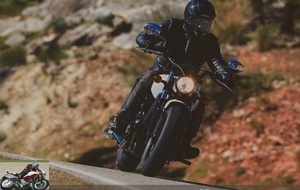
Motorway and expressways
The Kings Mountain custom soars vigorously towards the horizon, its block showing an astonishing length. The maximum power is delivered at 7,300 revolutions, but the breaker intervenes 1,200 revolutions higher. Unusual for a custom. In fact, both in style and performance, the Scout Sixty plays the power cruiser, thus reviving the sportiness claimed by its ancestor. Reaching 180 km / h is a mechanical formality, but a less pleasant test for the pilot. Especially since the block vibrates quite unpleasantly at constant high speed past the 5,500 revolutions.
In regulation, we appreciate the smoothness of the twin, purring at the fairly high value of 4,300 turns, ready to play the rubber bands. With each rotation of the handle, the motor then takes its turns without delay. A deflector will satisfy fast travel, but purists will prefer the secondary network.
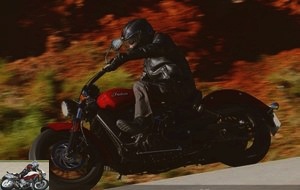
Departmental
The Indian approaches the roads at a good pace, aided by a very correct ground clearance for the segment. And, as expected, the Scout Sixty’s agility is very real, aided by a narrow rear tire. Rigid and stable, it reacts finely to the pressure exerted on the handlebars. In the tight bends of the Spanish hills, the cruiser then passes easily from one side to the other, keeping precisely the desired trajectory. Therefore, the outputs can be dynamic, maintained on the last two reports. Available, the block vigorously revives the crew, but without violence. If the twin does not lack character, it is logically less demonstrative than its elder. But with less inertia, the block of our Indian does not lack life anyway.
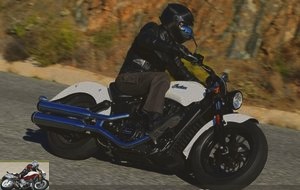
Provisions that the braking system manages efficiently. In use, the rear element is the most used at an uncovered pace, both to seat the machine and to limit mass transfers. Thus, the piloting is more nuanced. But when the pace picks up, the Indian can count on his front drive and the absence of parasitic reactions to the grip of the levers on the angle. Less precise, the ABS sometimes lets the rear wheel drift on heavy braking.
At a bucolic pace, the American is charming, punctuating curves and straight lines with ample piston strokes on a slight under-revving. All in top-notch comfort. The saddle nicely encompasses the pelvis and the soft density of its foams only pushes to lengthen the distances. Especially since the shock absorbers provide additional softness most of the time. Very flexible damping, however, takes off the rear wheel on rutted asphalt and during very important compressions at brisk speeds. In this regard, the hydraulics could be further slowed down. The fork also takes this treatment a little harshly, but testifies to a pleasant operation outside these rare and extreme conditions..
Cycle part
With great rigidity, the Indian cruiser is efficient and precise. Its geometry does not go overboard and its good balance makes the bike lively and easy to turn around. Intuitive and healthy, it lets the pilot concentrate on the pleasure of driving.
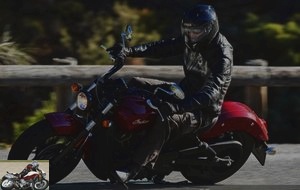
Braking
Sufficiently progressive and powerful, the simple front caliper efficiently manages the 256 kilos of the machine. The rear element assists it effectively and remains necessary to quickly stop the machine. Its implementation and particularly sensitive in curves to seat the cruiser.
Comfort / Duo
Remarkable, the seat provides first-class comfort, optimized by suspensions with studied flexibility. To take a passenger, you must first think about ordering a saddle. Likewise, solid optional lugs can accommodate the leather luggage..
Conclusion
As attractive as its predecessor, the Scout Sixty has forged its own personality. Always cultivating a skilfully distilled modernity, it wants to be more authentic and close to the legendary machine of 1920 by refining its accessories and its aesthetics. Efficient, its twin-cylinder does not lack trunk or charm, whatever the pace, serving as an efficient and safe cycle part..
It is then difficult to separate the sisters of Kings Mountain, close in many aspects. Less powerful, easier to finish, the novelty is above all less expensive. Priced at 11,990 €, it returns 1,660 € to the Scout. It’s both a little and a lot to equip yourself in multiple ways with this difference and strengthen your image, like a twin eager for independence..
It will be opposed to the Harley Davidson XL1200X Forty-Eight claiming 11,590 €. More typical in mechanics, it offers comparable mechanical performance, but both its mechanics and its cycle part are below the liveliness and rigor of the Indian.
A combination of history and technology, the Indian Scout Sixty is a stallion of choice for scouting and riding efficiently, riding a legend, with a unique style..
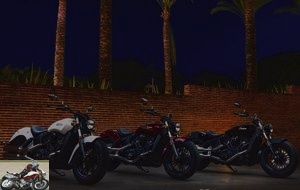
Strong points
- Engine character and availability
- Saddle height
- Agility of the cycle part
- Comfort
- Ergonomics
- Finishes
Weak points
- Exhaust too discreet of origin
- Commodos not bulky enough
- Hydraulic a little too free
The Scout Sixty technical sheet
Colors
- Indian Motorcycle Red.
- Thunder black
- Pearl White
Availablity
Right now
Indian Scout and Scout Sixty Differences
Black tint for frame, handlebars, headlight bowl, shock absorber springs. The engine decoration plates are freed from chrome and the profiles of the rims and cylinder heads are no longer polished. The saddle is vinyl.
Related articles
-
V2, 1133 cm3, 94 hp, 97 Nm at 5,600 rpm, 245 kilos dry, from € 13,990 A minimalist and stylish machine The air of nothing, this is an important machine…
-
Custom, live US cruiser or roadster Launched in 1920, the Indian Scout made a name for itself by defying the wall of death in 1928. Indian therefore…
-
Indian Chieftain Limited Trial
The bagger is updated with aesthetic and mechanical evolutions V2, 1811 cm3, 84 hp at 5000 rpm, 150 Nm at 2100 rpm, 364 kilos dry, from € 28,850 With the…
-
A complement to the Chief range: the 1811 cm3 light tourer, at € 27,000 Easily removable windshield and hard saddlebags, cruise control as standard, 372…
-
1731 cc, 89 hp, 139 Nm of torque, 296 dry kilos, € 13,490 An affordable, engaging and efficient power-cruiser with a very healthy chassis Mid-90s:…
-
Indian 1200 FTR Rally motorcycle test
Bite V-Twin, 1203 cm3, 120 hp, 120 Nm at 6,000 rpm, 235 kg TPF, 14,990 euros … daily test The word scrambler warms up lots of images, broadcast, told,…
-
Discovering the…. thing …. Canadian Neither motorcycle, nor trike, nor auto roadster … The BRP Can Am Spyder is a bit of all of this at the same time…
-
Long-term test over 6,000 km from the chef’s custom to the 1811 cm3 Mythical is the adjective that best fits the brand Indian and not just for Burt…
-
Indian FTR 1200 S Race Replica test
At the crossroads of genres V-Twin of 1,203 cm3, 123 hp and 120 Nm, 222 kg, 17,290 euros In November 2018, our colleague Alan Cathcart tried exclusively…
-
Born on the earth, built for the road V-Twin of 1,203 cm3, 120 hp and 115 Nm, 221 kg dry, Sachs suspension, Brembo brakes, from 14,690 euros It had to…
I confirm, the only negative point is the price.
Otherwise, it’s the ball !!
A real catapult out of a bend. The size 66 panard, a real pleasure bike.
I tried it for 45 minutes on expressways and small twisty roads. I agree with the test CR, except for the comfort, because this beautiful bike is a real ass-fuck that we are happy to get off.
Just for that I would not buy it ….
Otherwise there is less but it is cheaper! lol!